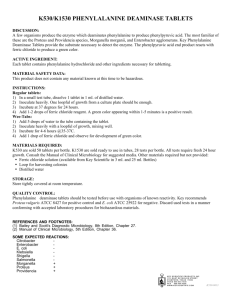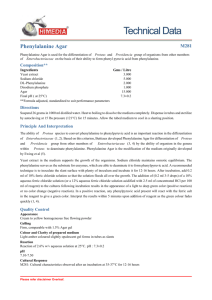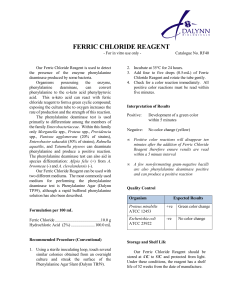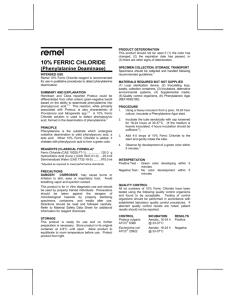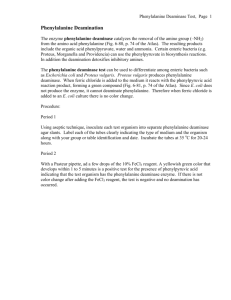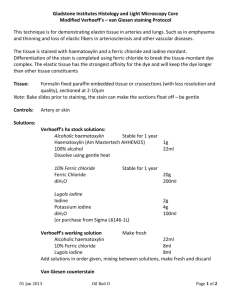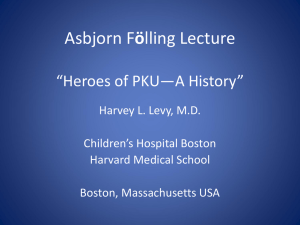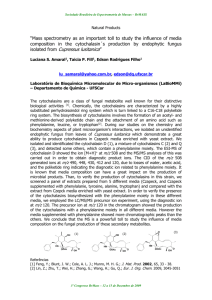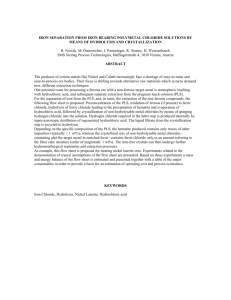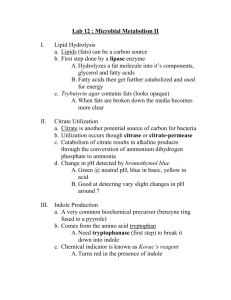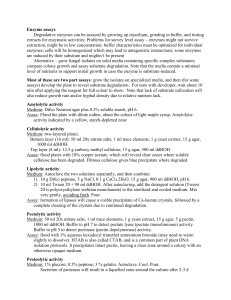base pdf dicto.indd
advertisement
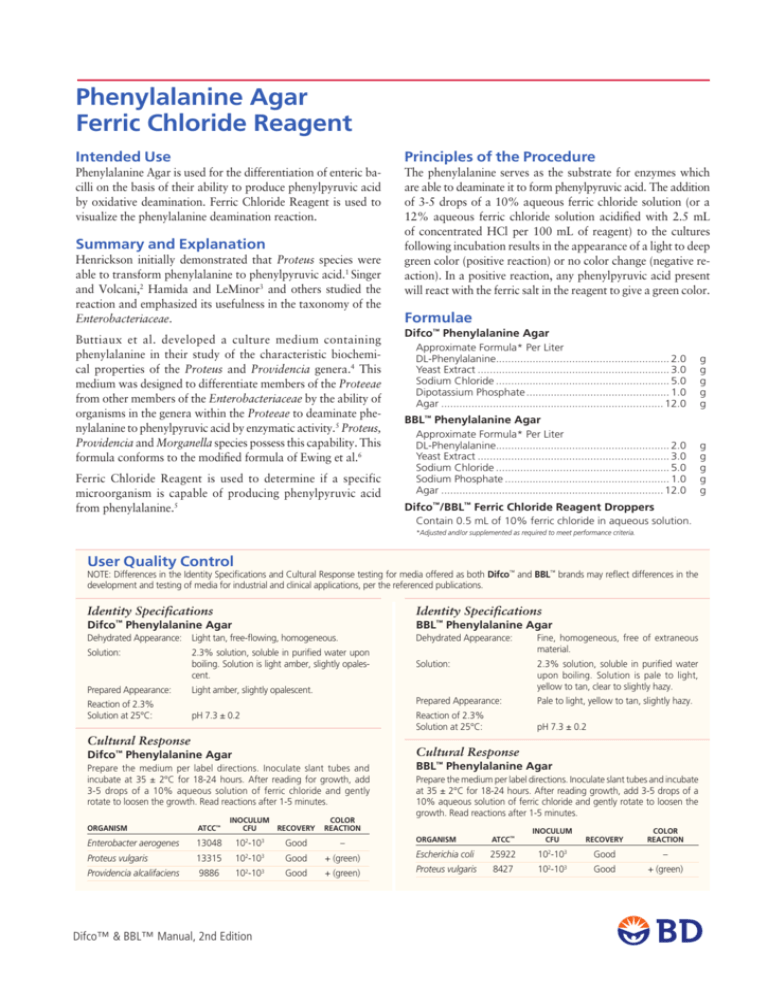
Phenylalanine Agar Ferric Chloride Reagent Intended Use Principles of the Procedure Phenylalanine Agar is used for the differentiation of enteric bacilli on the basis of their ability to produce phenylpyruvic acid by oxidative deamination. Ferric Chloride Reagent is used to visualize the phenylalanine deamination reaction. The phenylalanine serves as the substrate for enzymes which are able to deaminate it to form phenylpyruvic acid. The addition of 3-5 drops of a 10% aqueous ferric chloride solution (or a 12% aqueous ferric chloride solution acidified with 2.5 mL of concentrated HCl per 100 mL of reagent) to the cultures following incubation results in the appearance of a light to deep green color (positive reaction) or no color change (negative reaction). In a positive reaction, any phenylpyruvic acid present will react with the ferric salt in the reagent to give a green color. Summary and Explanation Henrickson initially demonstrated that Proteus species were able to transform phenylalanine to phenylpyruvic acid.1 Singer and Volcani,2 Hamida and LeMinor3 and others studied the reaction and emphasized its usefulness in the taxonomy of the Enterobacteriaceae. Buttiaux et al. developed a culture medium containing phenylalanine in their study of the characteristic biochemical properties of the Proteus and Providencia genera.4 This medium was designed to differentiate members of the Proteeae from other members of the Enterobacteriaceae by the ability of organisms in the genera within the Proteeae to deaminate phenylalanine to phenylpyruvic acid by enzymatic activity.5 Proteus, Providencia and Morganella species possess this capability. This formula conforms to the modified formula of Ewing et al.6 Ferric Chloride Reagent is used to determine if a specific microorganism is capable of producing phenylpyruvic acid from phenylalanine.5 Formulae Difco™ Phenylalanine Agar Approximate Formula* Per Liter DL-Phenylalanine.......................................................... 2.0 Yeast Extract................................................................ 3.0 Sodium Chloride.......................................................... 5.0 Dipotassium Phosphate................................................ 1.0 Agar.......................................................................... 12.0 BBL™ Phenylalanine Agar Approximate Formula* Per Liter DL-Phenylalanine.......................................................... 2.0 Yeast Extract................................................................ 3.0 Sodium Chloride.......................................................... 5.0 Sodium Phosphate....................................................... 1.0 Agar.......................................................................... 12.0 Difco™/BBL™ Ferric Chloride Reagent Droppers Contain 0.5 mL of 10% ferric chloride in aqueous solution. *Adjusted and/or supplemented as required to meet performance criteria. User Quality Control NOTE: Differences in the Identity Specifications and Cultural Response testing for media offered as both Difco™ and BBL™ brands may reflect differences in the development and testing of media for industrial and clinical applications, per the referenced publications. Identity Specifications Identity Specifications Difco™ Phenylalanine Agar BBL™ Phenylalanine Agar Dehydrated Appearance: Light tan, free-flowing, homogeneous. Dehydrated Appearance: Fine, homogeneous, free of extraneous material. Solution: 2.3% solution, soluble in purified water upon boiling. Solution is pale to light, yellow to tan, clear to slightly hazy. Prepared Appearance: Pale to light, yellow to tan, slightly hazy. Reaction of 2.3% Solution at 25°C: pH 7.3 ± 0.2 Solution: 2.3% solution, soluble in purified water upon boiling. Solution is light amber, slightly opalescent. Prepared Appearance: Light amber, slightly opalescent. Reaction of 2.3% Solution at 25°C: pH 7.3 ± 0.2 Cultural Response Cultural Response Difco™ Phenylalanine Agar Prepare the medium per label directions. Inoculate slant tubes and incubate at 35 ± 2°C for 18-24 hours. After reading for growth, add 3-5 drops of a 10% aqueous solution of ferric chloride and gently rotate to loosen the growth. Read reactions after 1-5 minutes. INOCULUM color CFU RECOVERY REACTION ORGANISM ATCC™ BBL™ Phenylalanine Agar Prepare the medium per label directions. Inoculate slant tubes and incubate at 35 ± 2°C for 18-24 hours. After reading growth, add 3-5 drops of a 10% aqueous solution of ferric chloride and gently rotate to loosen the growth. Read reactions after 1-5 minutes. ORGANISM ATCC™ INOCULUM color CFU RECOVERY REACTION Enterobacter aerogenes 13048 102-103 Good – Proteus vulgaris 13315 102-103 Good + (green) Escherichia coli 25922 102-103 Good – Providencia alcalifaciens 9886 10 -10 + (green) Proteus vulgaris 8427 102-103 Good + (green) 2 Difco™ & BBL™ Manual, 2nd Edition 3 Good g g g g g g g g g g Directions for Preparation from Dehydrated Product 1. Suspend 23 g of the powder in 1 L of purified water. Mix thoroughly. 2. Heat with frequent agitation and boil for 1 minute to completely dissolve the powder. 3. Dispense in tubes for slant cultures. 4. Autoclave at 121°C for 15 minutes. 5. Test samples of the finished product for performance using stable, typical control cultures. Expected Results Following the incubation period, add 3-5 drops of the ferric chloride reagent to the slants. Gently rotate the tube to loosen the growth. Observe for the production of a green color (positive reaction) within 1-5 minutes. Members of Proteus, Morganella and Providencia genera produce positive results. Most other genera within the Enterobacteriaceae are negative for phenylpyruvic acid production.7,8 References Procedure Using a heavy inoculum, inoculate tubed slants with growth from an 18- to 24-hour pure culture. Incubate tubes aerobically at 35 ± 2°C for 4 hours or 18-24 hours. If the inoculum is sufficiently heavy, a 4-hour incubation period should be adequate.5 1. 2. 3. 4. 5. Henrikson. 1950. J. Bacteriol. 60:225. Singer and Volcani. 1955. J. Bacteriol. 69:303. Hamida and LeMinor. 1956. Ann. Inst. Pasteur. 90:671. Buttiaux, Osteux, Fresnoy and Moriamez. 1954. Ann. Inst. Pasteur Lille. 87:375. MacFaddin. 1985. Media for isolation-cultivation-identification-maintenance of medical bacteria, vol. 1. Williams & Wilkins, Baltimore, Md. 6. Ewing, Davis and Reavis. 1957. Public Health Lab. 15:153. 7. Holt, Krieg, Sneath, Staley and Williams (ed.). 1994. Bergey’s Manual™ of determinative bacteriology, 9th ed. Williams & Wilkins, Baltimore, Md. 8. Murray, Baron, Jorgensen, Landry and Pfaller (ed.). 2007. Manual of clinical microbiology, 9th ed. American Society for Microbiology, Washington, D.C. Availability Difco™ Phenylalanine Agar BAM Cat. No. 274520 Dehydrated – 500 g BBL™ Phenylalanine Agar BAM Cat. No. 211537 Dehydrated – 500 g Difco™/BBL™ Ferric Chloride Reagent (10%) Cat. No. 261190 Droppers, 0.5 mL – Ctn. of 50 *Store at 2-8°C. Uninoculated Tube with Reagent Proteus vulgaris ATCC™ 13315 Difco™ & BBL™ Manual, 2nd Edition
